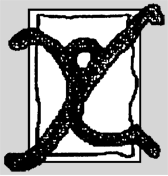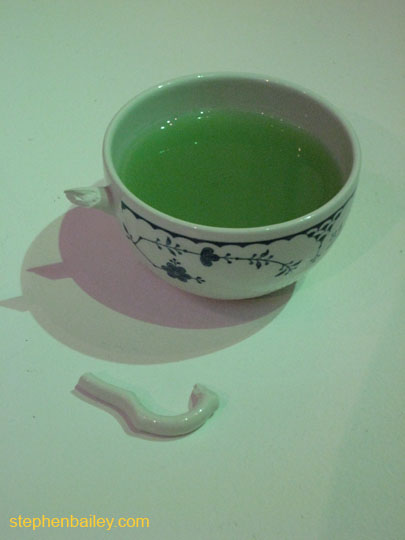Tonight at Openhouse Gallery in Soho, NYC, a bunch of media-types, mixologists and the just plain curious gathered at the launch party for La Fée Absinthe.
The Party
Thrown by La Fée Absinthe (distiller) and Genesis Beverage Brands (distributor), tonight’s shindig was held in a stark white, open space rightfully called Openspace Gallery (201 Mulberry St, NYC). It was time to celebrate the legal return of French absinthe to the US after nearly a century.
In October 2007, it was ruled that real absinthe could once again be imported and consumed in the US. The domestic sale of it is still a gray area and private distilling is still illegal. Then again, so is the private distilling of any liquor. But thankfully, the task of distilling has been left in the hands of experts for this party.
The traditional serving of absinthe is a sight to behold. An absinthe fountain is filled with crisp, cold icewater and a spoon with a sugar cube is placed on a glass. In the glass is about a shot’s worth of absinthe. A few ounces of water is slowly dripped onto the sugar and the sweet mix is passed thru the spoon, into the glass.
The result is the release of oils in the absinthe turning it from deep green to a more milky, cloudy color. And the taste? It’s a slightly bitter, spicy mix of herbs that transforms into a distinctly licorice-like flavor. And the kick? Oh there is a kick. Traditional absinthe is rated between 100 and 140 proof. Tonight’s treats from La Fée Absinthe were 136 proof.
Guests also had the pleasure of tasting a variety of concoctions. All delicious. While my favorite was the traditional serving, I really enjoyed something called ‘Sazerac with La Fée’ (twice). Made with just a splash of absinthe, a sugar cube, three dashes of bitters and two ounces of cognac.
Finger foods, great conversations and a run in with a plastic lobster completed the night. I would have liked more time to speak with the folks from La Fée, but they were being pulled in all directions. Since their inception, it’s been the company’s goal to bring back real absinthe to the world.
La Fée Absinthe
In 1998 George Rowley of La Fée Absinthe secured authorization in the UK allowing absinthe to be legally sold in the European Union. Soon after, he worked closely with absinthe historian Marie-Claude Delahaye to distill the first traditional absinthe in France since the bans of 1915.
Rowley and company can be proud to have played a role in sparking a worldwide absinthe revival which has finally spread back to American soil. Now guys like me will no longer need to wrap green bottles in sweat socks and old jeans, buried deep in a suitcase in order to enjoy the bitter pleasure.
So, Why the Long Wait?
In the early part of the 20th Century, absinthe was an unfortunate victim of the temperance movement both in Europe and the US. It’s high alcohol content and the use of wormwood (a potential neurotoxin) are part of what spawned the cries for a banning, as were tales of its psychogenic effects.
But there was more to it than the puritanical fear of the demon alcohol. In the late 1800s, the French wine industry was devastated by the phylloxera bug, swarms of which were destroying vineyards all over the country. With that, the public turned to the consumption of hard liquor. Absinthe became the people’s choice, therefore the bane of winemakers who began looking for ways to ban it.
Around that time, a disturbing news item from Switzerland helped stir up a banning frenzy. It read that Monsieur Lanfray killed his entire family after drinking absinthe. Blaming the effects of the wormwood and alcohol levels, the fact that he had also consumed six glasses of cognac, one brandy-laced coffee and two crème de menthes before picking up his gun, was ignored by officials.
Still, the Swiss government took this as a chance to ban the green stuff in 1907. Growing tales of the supposed evil effects of absinthe began to spread. The Netherlands followed with their own ban in 1909, the United States in 1912 and lastly France in 1915. It is reported that over 220,000,000 liters (yes indeed) of absinthe was consumed in France alone during that final year.
Exaggeration of Myths
Since the initial banning, most reported cases of so-called absinthism–as it became known–were found to be highly exaggerated and, in some cases, downright false. Historians believe the trumped up claims were nothing more than a tool used for continuing the ban. Much in the same way it is used today for certain recreational drugs like marijuana.
Many of the early incidents of absinthism came at a time when people regularly smoked opium or drank a lot of homemade, unregulated swill which used truly toxic items (i.e. copper sulfate for for coloring).
Truth is, the toxic effects of wormwood are virtually nonexistent at it’s levels when the traditional absinthe recipe is followed. This means that, by the time anyone was to drink enough to succumb to the supposed negative effects, they’d very likely die of alcohol poisoning.
What About that Green Fairy?
The most famous urban legend regarding absinthe is the idea that drinking just the right amount will conjure a visit from a green fairy. I for one am guilty of smuggling bottles into the country after a vacation abroad with high hopes of drinking to the point of a green visit that never happened. So why the persistence?
The closest thing I’ve come up with is, in it’s early incarnations during the late 1780s in France, absinthe was initially dubbed ‘La Fée Verte’ or The Green Fairy. This was thanks to it’s green tint and claims of it’s miraculous healing powers. After it’s ban, a mythology grew around absinthe, as is often the case in human society.
So anyone who thinks some cute little friend is waiting at the bottom of a bottle, forget it. There’s no green fairy, other than that nickname, still in use today.
See Also:
Photo Gallery
La Fée Absinthe
Genesis Beverage Brands
Openhouse Gallery




